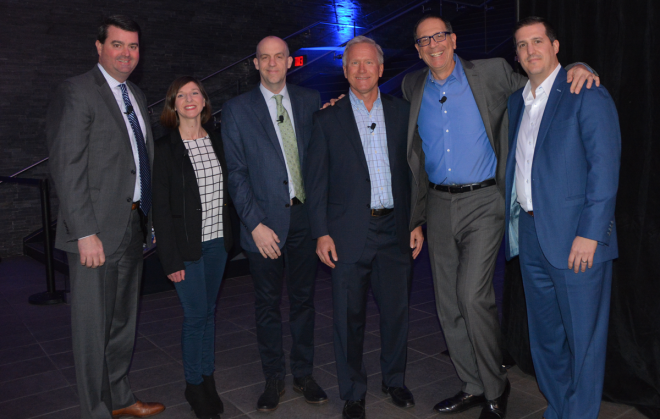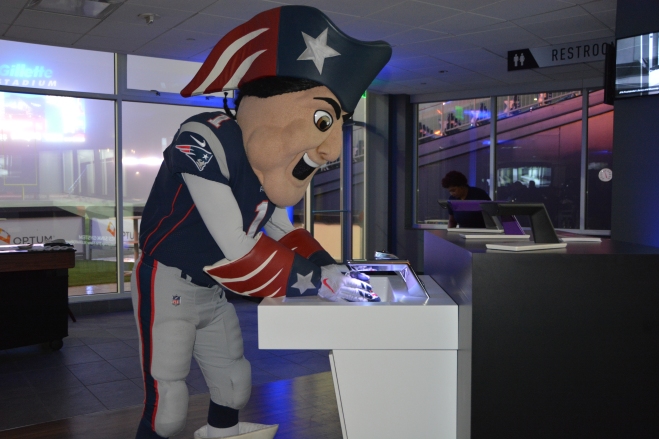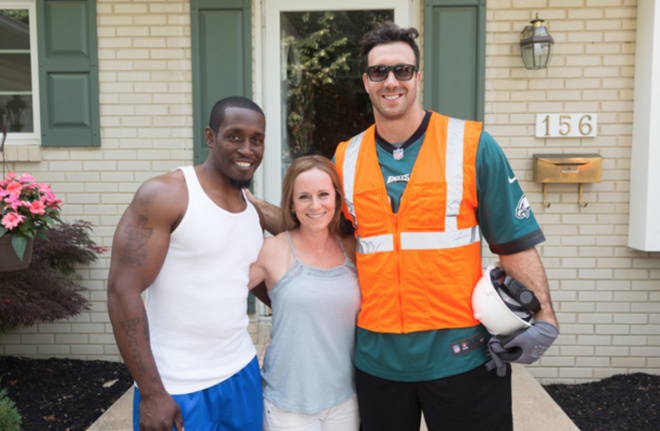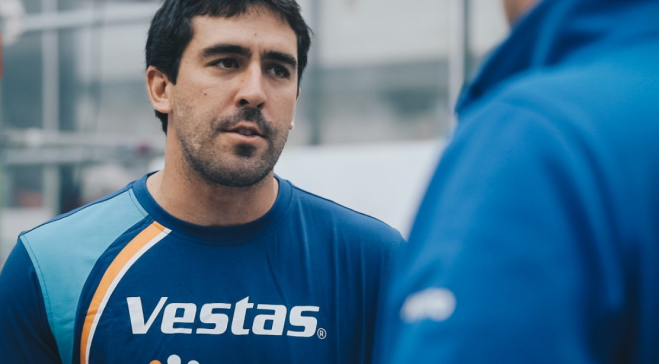The New England Patriots have been on the “Leading Edge” of pro football since 2001. After all, they are about to play in their ninth Super Bowl¹ in the 18-year Belichick-Brady era on Sunday when they take on the Los Angeles Rams in Atlanta.
Thus, it is fitting that the first Leading Edge Sustainable Stadium Design Conference was hosted by Excel Dryer and D|13 at the Pats’ Gillette Stadium last month.
The conference’s centerpiece was a discussion among a panel of Green-Sports All Stars. They took a deep dive into the past, present and especially the future of green sports venue design and operations, with an emphasis on how to make stadiums and arenas as energy efficient and fan-friendly as possible.
The opportunity to earn Continuing Education Unit (CEU) credits along with the chance to throw and catch passes on the same field as Tom Brady and Rob Gronkowski were likely what drew architects — as well as contractors, property managers and more — to Gillette Stadium on a foggy January night for the Leading Edge Sustainable Stadium Design Conference.

View from the field at Gillette Stadium during the Leading Edge Sustainable Stadium Design Conference (Photo credit: Excel Dryer)
But it was the panel discussion, moderated by Joe Khirallah of Green Bear Group, on the Green-Sports movement’s past, present and future, that kept the audience’s rapt attention.
“At several points during the discussion, I looked out to the audience and noticed that no one was looking at their cell phones,” observed panelist Scott Jenkins, GM of Atlanta’s LEED Platinum Mercedes-Benz Stadium and Board Chair of the Green Sports Alliance. “Not one person. I don’t think I’ve ever seen that before, and I’ve been on a lot of panels.”
PATRIOTS, GILLETTE STADIUM: GREEN-SPORTS INNOVATORS SINCE 2002
According to conference host and panelist Jim Nolan, who as COO of Kraft Sports + Entertainment (KSE) is responsible for operating Gillette Stadium as efficiently as possible, sustainability has been a core tenet since the building opened in 2002.
“I am fortunate to work for an owner — Robert Kraft — who cares about the environment,” Nolan shared. “Our number one priority is to reduce fossil fuel consumption. Second is to do as much as we can to reduce our waste stream. Every innovation we consider is examined through both financial and green lenses. We say ‘go’ on new cleantech innovations when they become economical.”
Examples of KSE’s “gos” include:
- An on-site system that converts waste water into gray water for use in the bathrooms and elsewhere throughout Gillette Stadium and neighboring Patriot Place, the 1.3 million square foot retail, restaurant and entertainment complex
- Energy efficient LED lighting, now illuminating the stadium and 90 percent of Patriot Place
- On-site solar, which now powers more than half of Patriot Place
Next up for Gillette and Patriot Place is a 2.4 megawatt (mW) fuel cell, expected to be fully operational next year. “Once we’re up and running, the entire campus will be off the grid,” reported Nolan. “We will also have a food waste converter that will produce methane gas — which will then go into the fuel cell to generate additional electricity.”
SUSTAINABLE SPORTS VENUES ARE A MARKETABLE ASSET
To Scott Jenkins, stadium and arena owner-operators who push green innovations reap more benefits than cost reductions and efficiencies, as important as those are.
“Most sustainability investments are clear winners for stadium and arena projects,” Jenkins asserted. “They show fans and the community that the team and the owner are purpose driven, which greatly enhances brand value. And sustainability can generate incremental revenue in the form of new, ‘green-focused’ sponsors. Forward-leaning owners like the Krafts and Arthur Blank — who pushed us to build Mercedes-Benz Stadium to earn LEED Platinum certification — believe that just building to code is like being OK with being a C student. They have to be A students.”
Chris DeVolder, lead architect on the Mercedes-Benz Stadium project and Managing Principal at HOK², chimed in that Blank “constantly pushed everyone who worked on the project to not only ‘think about what’s next’, but also ‘what’s next after what’s next’. Things like turning waste into energy to heat water, offering affordable vegetarian and vegan food options, and more.”
PATS CONNECT FANS TO SUSTAINABILITY IN GILLETTE STADIUM RESTROOMS
Panelist Summer Minchew, Managing Partner of Washington, D.C.- and Charlotte, NC-based Ecoimpact Consulting, and a veteran of several venue projects, offered that fans are a key element to the Green-Sports equation.
“It may sound obvious, but a positive fan experience at a sports venue is absolutely key,” Minchew said. “What is not always so obvious to stadium designers, managers and owners, is that sustainability, from environmental, health and wellness points-of-view, goes hand in hand with a great fan experience.”
According to Jim Nolan, the Patriots have been a bit late to the “fan engagement” party but they are making significant strides in the right direction. Working with energy partner NRG, the team communicates its solar story to fans via signage mounted on massive pillars near the stadium’s entry gates.
Once inside Gillette, fans experience the leading edge of sustainable stadium design when they dry their hands in the restrooms via a unique, high-velocity, two-phase drying process. The XLERATOR® from Excel Dryer — one of the sponsors of the Leading Edge conference — blows large water droplets off the hands in a couple of seconds in Phase 1. Then, in Phase 2, the heat evaporates a residual moisture layer that we feel but don’t see. This makes the drying process about three times faster than conventional hand dryers, resulting in an 80 percent reduction in energy usage.
But that’s not the XLERATOR’s greenest feature.
Replacing paper towels is.
A Life Cycle Assessment (LCA) showed that the XLERATOR was the catalyst for up to a 75 percent reduction in carbon footprint when compared to 100 percent recycled paper towels. That might seem counterintuitive but, after one-time use, paper towels go straight to the landfill. So XLERATORs help reduce paper production, transportation emissions, water usage, waste and more.
“The XLERATOR is a win-win-win-win for us,” enthused Nolan. “First, it’s clearly better for the environment. Second, it saves time and manpower as our staff spends much less time cleaning paper from the floor and refilling paper towel dispensers. Third, that allows staff to respond more quickly to other fan issues. Fourth and most importantly, the fans prefer the XLERATOR to paper, so they have a better experience.”

From left, Jim Nolan, COO of KSE and host of the Leading Edge Sustainable Design Conference welcomes fellow panelists Summer Minchew, Chris DeVolder, Scott Jenkins, moderator Joe Khirallah, and Bill Gagnon, Vice President of Sales and Marketing with event sponsor Excel Dryer (Photo credit: Excel Dryer)
Guests at Gillette Stadium’s Optum Field Lounge this season got to experience another futuristic hand drying “win” with the recent installation of a next-generation sink system from Leading Edge sponsor D|13.
“The system features, from left to right, liquid soap dispenser, water faucet, and the XLERATORsync®, in one contained unit,” Nolan said. “It keeps water in the sink, which is better for the environment. Maintenance visits are reduced. It is the most sustainable, hygienic way to wash your hands. We’re excited to be the first stadium to feature the D|13 Sink System.”

Leading Edge Sustainable Design Conference attendees, including Pat Patriot, had the opportunity to try out the new D|13 Sink System (Photo credit: D|13)
Will Mercedes-Benz Stadium be the second? Too early to tell. After all, Scott Jenkins and the rest of the staff are busy getting ready to sustainably welcome the Patriots, Rams and 70,000+ fans for Super Bowl LIII on Sunday.
¹ The nine Super Bowls of the Belichick-Brady era: 2002 (Pats over Rams), 2004 (Pats over Panthers), 2005 (Pats over Eagles), 2008 (Giants over Pats), 2012 (Giants over Pats), 2015 (Pats over Seahawks), 2017 (Pats over Falcons), 2018 (Eagles over Pats), 2019 (Pats vs. Rams)
² HOK is a global design, architecture, engineering and planning firm


